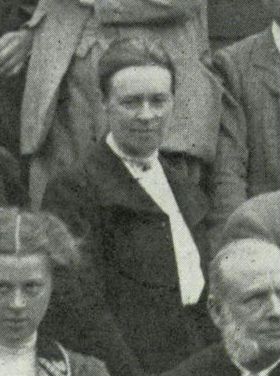
Penicillium is a genus of ascomycetous fungi that is part of the mycobiome of many species and is of major importance in the natural environment, in food spoilage, and in food and drug production.
Penicillium griseofulvum is a species of the genus of Penicillium which produces patulin, penifulvin A, cyclopiazonic acid, roquefortine C, shikimic acid, griseofulvin, and 6-Methylsalicylic acid. Penicillium griseofulvum occurs on cereals and nuts.
Penicillium aethiopicum is a fungus species of the genus of Penicillium. Penicillium aethiopicum produces viridicatumtoxin and griseofulvin, two structurally interesting polyketides.
George Smith was a British mycologist. Born in Great Harwood, he graduated from the University of Manchester in 1916 with first-class honours, and received his Master's degree in chemistry two years later. After starting a laboratory with the textile manufacturing company Boardman and Baron Ltd. in 1919, he began to study the mildew and moulds that grew on goods made from cotton.
Penicillium clavigerum is a fungus species of the genus of Penicillium which produces fumigaclavine A and fumigaclavine B
Penicillium dimorphosporum is an anamorph species of the genus of Penicillium.
Penicillium erythromellis is an anamorph species of the genus of Penicillium.
Penicillium freii is a psychrophilic species of the genus of Penicillium which produces xanthomegnin and patulin. Penicillium freii occurs in meat, meat products, barley and wheat
Penicillium isariiforme is an anamorph, phototropic species of the genus of Penicillium which produce secalonic acid D and F.
Penicillium janczewskii is an anamorph and filamentous species of the genus of Penicillium which was isolated from the rhizosphere of Vernonia herbacea. Penicillium janczewskii produces griseofulvin

Gulielma Lister was a British botanist and mycologist, and was considered an international authority on Mycetozoa.
Penicillium nordicum is an anamorph species of fungus in the genus Penicillium which produces ochratoxin A. Penicillium nordicum contaminates protein rich foods and foods with high NaCl-konzentration. It is mostly found on dry-cured meat products and cheese products
Penicillium olsonii is an anamorph, filamentous species in the genus Penicillium which produces several polygalacturonases, xanthoepocin, asperphenamate, verrucolone, phthalate and olnacin. Penicillium olsonii is an often source of spoilage of tomatoes, salami and beans This species occurs ubiquitously in soil
Penicillium persicinum is a species of fungus in the genus Penicillium which was isolated from soil from the Qinghai Province in China. Penicillium persicinum produces griseofulvin, lichexanthone, roquefortine C, roquefortine D, patulin and chrysogine
Penicillium thiersii is a species of fungus in the genus Penicillium which was isolated from a wood decay fungi (Hypoxylon) in Wisconsin in North America. Penicillium thiersii produces thiersindole A, thiersindole B, thiersindole C, oxalicine A and oxalicine B
Walter Philip Kennedy Findlay was a US-born British mycologist.

Ligniera is a protist genus of the family Plasmodiophoraceae.
Kathleen Sampson was an English mycologist and plant pathologist, with a focus in herbage crops and cereal diseases. She was a leading authority on smut fungi growing in the British Isles.
Philip Herries Gregory was a British mycologist and phytopathologist. He established an international reputation as a pioneer of aerobiology and a leading expert on the liberation and dispersal of fungal spores and their relation to plant diseases and to human respiratory diseases. In 1957 he was elected to a one-year term as president of the British Mycological Society.
Samuel Paul Wiltshire was an English mycologist and phytopathologist. For the academic year 1943–1944 he was the president of the British Mycological Society.


